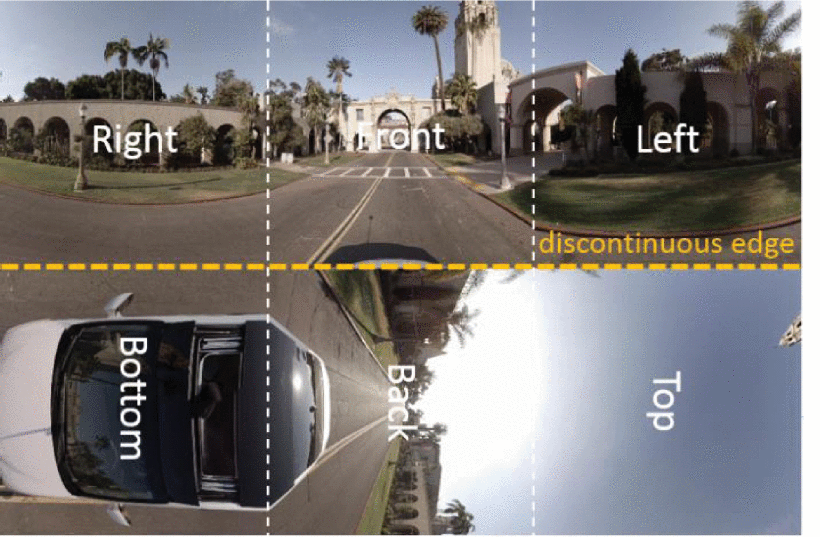ffmpeg -i dacapo.jpg -vf v360=input=equirect:output=eac dac_eac.jpgEqui-Angular Cubemap in ffmpeg v360:

dac_eac.jpg (8000x4500 px)
Here I'm using the equirectangular dacapo.jpg zipped (8000x4000 px) to make an Equi-Angular Cubemap (8000x4500 px)
ffmpeg -i dacapo.jpg -vf v360=input=equirect:output=eac dac_eac.jpg
Equi-Angular Cubemap in ffmpeg v360:

dac_eac.jpg (8000x4500 px)
left 0 front 0 right 0Paul Bourke has info on these: Pixel efficiency considerations (EAC: EqualAngular cubemaps).
down -90 back 90 up -90
ffmpeg -i dac_eac.jpg -vf v360=input=eac:output=c3x2 dac_3x2.jpg

hcross_wb.webp
Horizontal cross, this order is not ffmpeg v360 order. But it shows the pitch rotation of top (up) and bottom (down) faces.
Panotools and similar:
Face front right back left top bottomI like this horizontal cross format, you can cut, fold and glue a print to form an actual cube.
Yaw 0 90 180 -90 0 0
Pitch 0 0 0 0 90 -90

5) Virtual Boundaries:
Virtual boundaries are boundaries within pictures where the in-loop filter operations that would apply across the boundaries are disabled. The granularity of the possible locations of virtual boundaries is eight luma samples. This feature serves two purposes. The first is for avoiding seam artifacts introduced by applying the in-loop filters across an artificial boundary created by a preprocessing step before encoding, e.g., a boundary that can occur when a multi-face projection format such as the cubemap projection (CMP) [19] is used to represent a 360° video during coding. Each CMP picture contains a layout of six cubemap faces, as shown in Fig. 3. However, while the upper and lower rows of three faces are continuous in the spherical domain, a discontinuity exists between the upper and lower rows, shown by the horizontal “discontinuous edge” in Fig. 3. Such a boundary can be signaled as a virtual boundary to disable the in-loop filter operations across the boundary, to avoid mixing of spherically non-neighboring samples together during in-loop filtering, which could harm the subjective quality. Although it is possible to partition the picture such that the boundary between the upper and lower face rows coincide with tile boundaries or slice boundaries, across which the in-loop filters could be disabled to achieve similar subjective effect, defining virtual boundaries and disabling loop filtering across them provides more flexibility for 360° video coding, because the latter does not require the cubemap face width or height to be a multiple of the CTU size.

bross3-3101953-large.gif Fig. 3.
(equirectangular projection (ERP)
cubemap projection (CMP)
generalized cubemap projection (GCMP)
padded versions of the above.)
ref: ieee.org/document/9503377
See also:
A COMPREHENSIVE COMPARISON OF PROJECTIONS IN OMNIDIRECTIONAL SUPER-RESOLUTION
arXiv:2304.06497v1 [cs.CV] 13 Apr 2023